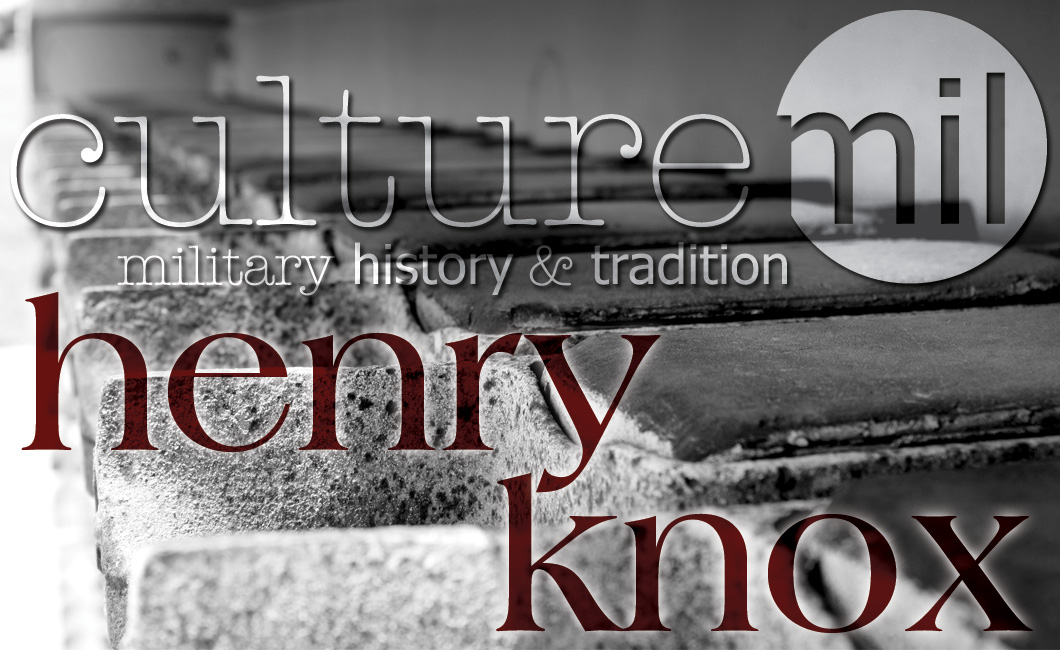Written by Jenifer Chrisman on June 2, 2015.
“I am not what happened to me, I am what I choose to become.”
– Carl Gustav Jung
Born July 25, 1750, in Boston, Massachusetts, Henry Knox was raised by his single mother after his father, unable to provide for the family, left for the West Indies. Three years after his father’s death in 1759, Knox, as the oldest surviving son still at home, left school and took a clerk job in a bookbindery to support his mother.
With only a fifth grade education, Knox taught himself by reading every book he could get his hands on, most especially military tactics on artillery and ordinance. His passion was so strong he also taught himself French in order to read books that had not yet been translated.
Knox never let the poverty he had been born into or his lack of education stand in his way. He joined the local militia and eventually saved up the money to open his own bookstore, The London Book Shop.
Miss Lucy Flucker of Boston and Philadelphia became a frequent visitor at the bookshop after catching sight of Knox engaged in maneuvers at the Boston Common. It was love at first glimpse. She, in turn, stole his heart and, despite her parents’ strenuous protests against the match, they were married in a small ceremony in June of 1774. They had 13 children, 10 of whom predeceased them.
Knox abandoned his thriving bookshop to looters in 1775, on the heels of the colonists’ formal rebellion against the crown following the battles of Lexington and Concord. He was just 25. With his new bride at his side and his sword sewn inside her cape they snuck out of Boston and joined the “rabble in arms” in Cambridge just across the Charles River.
The Continental Congress delegates selected Virginia representative George Washington to lead the newly forming army. In turn, Washington selected two of the 14,000 gathered at Cambridge to help him lead, Nathanael Greene, a Quaker with a limp, and Henry Knox, who had impressed him with his engineering and artillery knowledge and skills. Knox, who wasn’t commissioned at the time, received his commission as a colonel of the army’s artillery regiment through the work of John Adams in the Second Continental Congress.
With the siege unbroken, Knox is credited with suggesting to Washington that retrieving the recently captured cannons from the fall of forts Ticonderoga and Crown Point in upstate New York could turn the tides of the battle. Tasked with the assignment, Knox, whose commission had yet to arrive, departed for Ticonderoga, arriving in December of 1775.
The 60 tons of cannons and other armaments were hauled by ox-drawn sled across snow-covered mountains and iced-over rivers some 300 miles to the siege camps. Due to difficulties in hiring personnel and draft animals, as well as cannons crashing through ice and needing to be retrieved, the expedition took more than six weeks, arriving on January 27, 1776. They were deployed to fortify the recently taken Dorchester Heights. The British, after taking stock of the new fortifications, withdrew their fleet to Halifax, thus ending the siege.
Knox’s expedition has been called “one of the most stupendous feats of logistics” of the entire war by historian Victor Brooks. It is commemorated by a series of plaques in New York and Massachusetts marking the Henry Knox Trail.
Knox was Washington’s right hand man throughout the war and a life-long friend. He accompanied Washington on most of his campaigns, including Bunker Hill, Trenton, Yorktown, Brandywine, Valley Forge and he stood beside Washington as he crossed the Delaware. He served Washington as Chief Artillery Officer in the Continental Army, then as a General in the United States Army (March 22, 1782 –becoming the army’s youngest major general) and finally as Secretary of War as one of then President Washington’s first five cabinet members.
Rather than see the only real institution binding the newly formed United States of America disband after the war ended, Knox proposed the fraternal organization, the Society of Cincinnati, be formed. Named after the Roman warrior Cincinnatus, the Society would continue to unite the commissioned officers of the Continental Army. It is now the oldest patriotic organization in the nation with over 3,900 members and is headquartered in Washington, DC.
Knox and his wife moved to the District of Maine where he built Montpelier on 576,000 acres of land Lucy inherited from her family, helped establish a local church, started a local militia group and dabbled in a variety of business from shipping timber to quarrying lime, which enabled him to employ many of the townspeople. Before any of his business ventures took hold, he passed away on October 25, 1806, after swallowing a chicken bone at a picnic.
According to Dr. Hermon Small, “His funeral was conducted with many honors. An imposing procession was formed, preceded by a company of militia marching with arms reversed; then a company of artillery, followed by a company of cavalry, these preceding the coffin, on which lay the General’s hat and sword. Behind was the hero’s favorite horse, with boots of the late rider reversed in the stirrups. Then followed relatives, domestics, citizens and strangers. This long procession marched to the music of a solemn dirge, accompanied by muffled drums, tolling of bells, and minute guns fired from the height.” Henry Knox, a great man who started from humble beginnings, was laid to rest at the old cemetery in Thomaston, Maine.
Story requested by: Kenneth Knox, direct descendant.
Sources:



